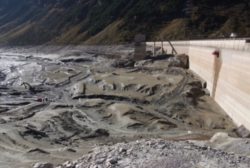
ECOHYDRAULICS
Ecohydraulics is an interdisciplinary science that facilitates a deeper understanding of processes and enables targeted management of river landscapes, including their anthropogenic changes and uses.
Applications of ecohydraulics are particularly relevant in assessing existing or future changes in flowing waters and their impacts on aquatic ecosystems. By overlaying habitat characteristics, such as flow velocities and water depths, with habitat requirements, diverse methods for analyzing and evaluating human interventions and changing environmental factors emerge. These evaluations are essential for direct interventions, such as flood protection projects or hydropower utilization, as well as for indirect changes resulting from climate change.

Sustainable Hydropower – Hydropeaking
Numerical methods in ecohydraulics are used to assess and optimize the impacts of peak electricity generation by storage hydropower plants. Unsteady hydrodynamic models are combined with the ecological requirements of indicator species, such as fish and macrozoobenthos, to evaluate habitat suitability in hydropeaking stretches during base flow (low flow, or “Sunk”) and to quantify changes caused by hydropeaking events. In this context, area and cross-sectional analyses are applied to quantify the extent of areas that dry out during transitions from hydropeaking to low flow (hydropeaking to Sunk) and to analyze the morphological impacts on flow velocities during low flow conditions.
Sustainable Hydropower – Reservoirs
At IWA, new integrative approaches have been developed to predict the ecological development of reservoir stretches, particularly in the context of progressive sediment deposition. The sediment dynamics approach in ecohydraulics is based on the principle that rivers strive for equilibrium through sediment transport and deposition. This approach has been integrated into numerical methods to evaluate reservoir stretches based on bioregions and transported sediments. This enables targeted planning of measures to optimize ecological and hydrodynamic conditions.
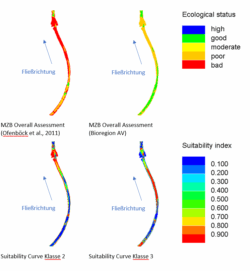
Sustainable Hydropower – Residual Water
The detectability of fish migration routes, both upstream and downstream, and the hydraulic optimization of near-natural migration pathways for aquatic organisms at existing or new river continuity interruptions are central applications of ecohydraulics. Using multidimensional flow models, detailed analyses are conducted as part of monitoring efforts and structural optimizations.
Sustainable Hydropower – Fish Passages
The detectability of fish passages, both upstream and downstream, and the hydraulic optimization of natural-like migration opportunities for aquatic organisms at existing or new interruptions in river continuity, is a central application area of ecohydraulics. Multidimensional flow models are used here for detailed analyses during monitoring or structural optimizations.
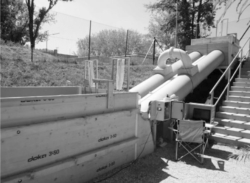
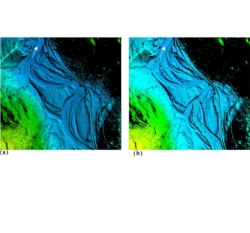
Integrated Hydraulic Engineering and Flood Protection
In the context of European and national legislation, it is necessary to consider not only the primary aspects of flood safety in flood protection measures but also the objectives of the European Water Framework Directive. This means that ecological aspects and requirements must be integrated into the planning and implementation of flood protection projects. Ecohydraulic approaches are used to reconcile the dual objectives of “protection from water” and “protection of water” by incorporating detailed spatial resolutions of river geometries. The focus is on evaluating the potential ecological use of the project area across the entire flow spectrum.
Waterway Management
Active sediment management and river engineering measures are essential for maintaining navigable waterways such as the Danube, Elbe, and Rhine. Ecohydraulic methods are applied to assess the impacts of these interventions, minimizing potential negative effects and improving the ecological status of water bodies through targeted, integrative approaches involving structural elements. Numerical methods are used to analyze sediment transport and morphological development, which are then coupled with ecological requirements at the guild level (large ecological groups).
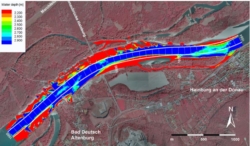
Assessing the Impacts of Climate Change
Similar to the evaluation of residual water flows in the context of hydropower, the analysis of global warming’s impacts on river ecology focuses on water availability. Integrative predictive models are used to link precipitation and runoff trends with numerical ecohydraulic methods, enabling quantitative projections of future hydrological developments. A particular focus is on modeling water temperature changes, which influence pollutant transport and must be integrated into the analyses.
Sediment Balance and Sediment Management
The application of ecohydraulics in sediment management is highly interdisciplinary and closely linked to hydropower utilization. This involves analyzing flow conditions in relation to aquatic organisms, such as fish, as well as numerically evaluating the dynamic components of sediment balance. This includes assessing the dynamics of riverbed rearrangement with respect to habitat stability and renewal, as well as evaluating the impacts of increased suspended sediment loads on indicator species in flowing waters.
